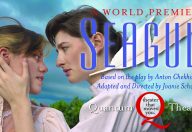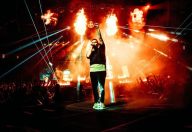Bob Dylan: American Master
Wouldn’t it have been great if Bob Dylan played mainly his top hits at his Heinz Hall concert Thursday night?
Well, yes and no. Yes, because we know and love those hooky-riffed, deep-meaning songs. No, because that’s not Dylan. This is the man who’s often been a contrarian, the man who marches to the beat of a different drummer. Like when he alienated some of his folk music fans in ’65 playing a rock set at the Newport Folk Festival, including his then-new single “Like a Rolling Stone.” Many in the crowd booed.
Dylan’s attitude, however, makes him relevant today, producing quality new music and not someone who’s on a greatest hits tour.
It was this attitude that also gave his Pittsburgh audience a highly enjoyable show of mainly newer with some earlier songs from the rich and diverse Dylan songbook. With more albums (11) on Rolling Stone’s list of the 500 Greatest Albums of All Time—one more than the Beatles’ and the Stones’—this gives him a lot to pull from.
Dylan’s ways were also evident in how the concert was performed. The set list was the same as most of the shows on this leg of his Never Ending tour. The concert was structured like a theatrical performance, with two sets (acts) separated by an intermission. Photography and videography were strictly forbidden and enforced by ushers, security personnel, and light techs who shone a light on the offenders. People soon got the message, and it made for a more enjoyable concert experience. No one would be making a bootleg video.
Subtle Staging
The stage was simply set with mid-rise spotlight stands arranged symmetrically to illuminate the band members’ playing areas. There were two risers—one for the drummer and the other for the slide guitar and other instrument players. At the rear was a high curtain bunched in some spots, like drapes. Several times during the show different designs were projected onto the backdrop. The only other adornment was what appeared to be a white sculpture of a woman’s head on a table at stage left. The limited lighting and sparse staging put the focus where Dylan wanted it—on himself and his band members.
On With the Show
Dimmed lighting and subtle gong sounds signaled that Dylan and band would soon be taking the stage. Dylan—dressed like a country western dandy in a medium-tan suit, matching pants with a stripe running down the side, and a western-style hat curled slightly at the brim—received a warm standing ovation from the enthusiastic crowd.
Without a word, Dylan and band launched into the first set with “Things Have Changed.” The second song, “She Belongs to Me,” brought the tempo down a little and saw the first Dylan harmonica playing of the night, which the crowd loved. The set continued into relatively newer songs, including “Beyond Here Lies Nothin,'” a simmering blues-rock song with an enticing syncopated drum beat. “Workingman Blues” had a southwestern/country flavor and featured some very nice slide and electric guitar work. There was a country-waltz feel in the next mix with “Waiting for You.” “Duquesne Whistle” introduced a standup bass to the band sounding reminiscent of an old-time jazz or pop song; it also displayed Dylan’s mastery of the piano. Nice steel guitar notes opened “Pay in Blood,” and Dylan and band returned to some simmering blues rock with a really cool nuanced sound that one doesn’t hear from most bands. It seemed as if they had gone beyond standard notes, chords, and arrangements on this and other songs to create some unique sounds.
Strumming acoustic guitar notes and the opening words “Early one morning the sun was shining and she was lying in bed” announced that Dylan was walking us down memory lane with “Tangled Up in Blue,” from ’75’s Blood on the Tracks. Dylan again displayed his harmonica talents throughout this song. When it ended, Dylan uttered his first salutation of the night—a simple, “Thank you.” Time for Intermission.
The Audience
The audience was mainly boomers from all socioeconomic backgrounds; there was also a sprinkling of younger knowledge seekers. Everyone mingled nicely and enjoyed seeing a concert within the beautiful confines of Heinz Hall. One man, a middle-aged teddy bear, was especially enjoying the show as he danced in the far left aisle the entire night. His dance moves were intriguingly good—and, nicely, security let him do his thing.
Second Set and Encore
The second set opened with “Love Sick,” followed by “High Water (For Charley Patton).” With nice banjo and standup bass parts, it sounded like it would fit right in with the currently popular Americana music. Following was “Simple Twist of Fate.” The Tempest‘s “Early Roman Kings” had a rolling Chicago blues sound that Muddy Waters would’ve surely approved of. “Forgetful Heart” contained some beautiful violin and harmonica parts. Next up was “Spirit on the Water,” which once again found Dylan skillfully ticklin’ the ivories and playing harmonica. “Scarlet Town” contained some rich storytelling lyrics, including “Play it for my flat-chested junkie whore.” “Soon After Midnight” ensued, and was followed by “Long and Wasted Years,” with a pleasantly repetitive country sound.
That ended the second set, and Dylan and band joined up at center stage during a sustained round of applause, took a bow, and walked off stage. The applause continued, and Dylan and band returned after a few minutes for an encore set. “Blowin’ in the Wind,” from his second album The Freewheelin’ Bob Dylan, kicked off the two-song finale and featured Dylan playing piano and harmonica. “Blowin’ in the Wind” is a tremendous song both lyrically and musically. “Stay With Me” closed the concert.
Talented Musicians
Dylan and his band members are top-notch musicians who play some of the greatest American songs of the last 60 years. Rarely playing guitar since introducing piano to the concert lineup several years back, Dylan reportedly has said that he enjoys the sound piano gives to his songs. He is a talented pianist, whether playing in a honky tonk or more classical style. With a lineup of talented guitarists that includes Charlie Sexton (lead), Tony Garnier (bass and unnamed music director), Stu Kimball (rhythm), and Donnie Herron (pedal steel, banjo, mandolin, and violin), guitar playing is still a highlight of a Dylan show. Drummer and percussionist George Receli provides a solid foundation for the band.
The incredible acoustics of Heinz Hall allowed for crisp and clear projection of the sound, and helped to crystallize Dylan’s traditionally nasally voice a little more, even though some lyrics were still hard to discern. That’s one of the unique aspects of a Dylan show and part of his style.
During the concert, Dylan occasionally did a little sauntering and several times struck a subtle pose with one foot slightly ahead of the other. This shouldn’t surprise us, as he’s always been an important and sometimes understated persona on the American music and cultural scene. Seeing Dylan in concert was an interesting and enjoyable experience.
Share on Social Media
Follow Entertainment Central
Latest Stories
Sign up for the EC Newsletter







